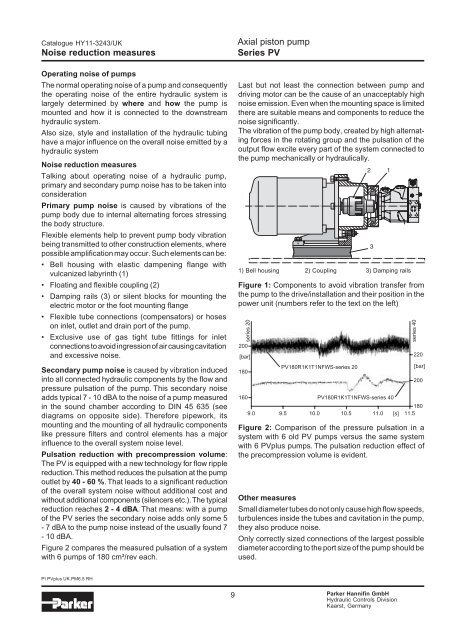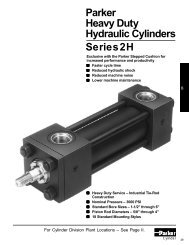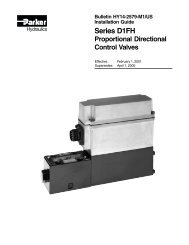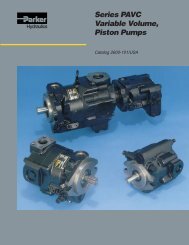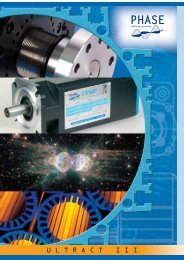Axial Piston Pump Series PV
Axial Piston Pump Series PV
Axial Piston Pump Series PV
You also want an ePaper? Increase the reach of your titles
YUMPU automatically turns print PDFs into web optimized ePapers that Google loves.
Catalogue HY11-3243/UK<br />
Noise reduction measures<br />
Operating noise of pumps<br />
The normal operating noise of a pump and consequently<br />
the operating noise of the entire hydraulic system is<br />
largely determined by where and how the pump is<br />
mounted and how it is connected to the downstream<br />
hydraulic system.<br />
Also size, style and installation of the hydraulic tubing<br />
have a major influence on the overall noise emitted by a<br />
hydraulic system<br />
Noise reduction measures<br />
Talking about operating noise of a hydraulic pump,<br />
primary and secondary pump noise has to be taken into<br />
consideration<br />
Primary pump noise is caused by vibrations of the<br />
pump body due to internal alternating forces stressing<br />
the body structure.<br />
Flexible elements help to prevent pump body vibration<br />
being transmitted to other construction elements, where<br />
possible amplification may occur. Such elements can be:<br />
Bell housing with elastic dampening flange with<br />
vulcanized labyrinth (1)<br />
Floating and flexible coupling (2)<br />
Damping rails (3) or silent blocks for mounting the<br />
electric motor or the foot mounting flange<br />
Flexible tube connections (compensators) or hoses<br />
on inlet, outlet and drain port of the pump.<br />
Exclusive use of gas tight tube fittings for inlet<br />
connections to avoid ingression of air causing cavitation<br />
and excessive noise.<br />
Secondary pump noise is caused by vibration induced<br />
into all connected hydraulic components by the flow and<br />
pressure pulsation of the pump. This secondary noise<br />
adds typical 7 - 10 dBA to the noise of a pump measured<br />
in the sound chamber according to DIN 45 635 (see<br />
diagrams on opposite side). Therefore pipework, its<br />
mounting and the mounting of all hydraulic components<br />
like pressure filters and control elements has a major<br />
influence to the overall system noise level.<br />
Pulsation reduction with precompression volume:<br />
The <strong>PV</strong> is equipped with a new technology for flow ripple<br />
reduction. This method reduces the pulsation at the pump<br />
outlet by 40 - 60 %. That leads to a significant reduction<br />
of the overall system noise without additional cost and<br />
without additional components (silencers etc.). The typical<br />
reduction reaches 2 - 4 dBA. That means: with a pump<br />
of the <strong>PV</strong> series the secondary noise adds only some 5<br />
- 7 dBA to the pump noise instead of the usually found 7<br />
- 10 dBA.<br />
Figure 2 compares the measured pulsation of a system<br />
with 6 pumps of 180 cm³/rev each.<br />
PI <strong>PV</strong>plus UK.PM6.5 RH<br />
9<br />
<strong>Axial</strong> piston pump<br />
<strong>Series</strong> <strong>PV</strong><br />
Last but not least the connection between pump and<br />
driving motor can be the cause of an unacceptably high<br />
noise emission. Even when the mounting space is limited<br />
there are suitable means and components to reduce the<br />
noise significantly.<br />
The vibration of the pump body, created by high alternating<br />
forces in the rotating group and the pulsation of the<br />
output flow excite every part of the system connected to<br />
the pump mechanically or hydraulically.<br />
1) Bell housing 2) Coupling 3) Damping rails<br />
Figure 1: Components to avoid vibration transfer from<br />
the pump to the drive/installation and their position in the<br />
power unit (numbers refer to the text on the left)<br />
series 20<br />
200<br />
[bar]<br />
180<br />
<strong>PV</strong>180R1K1T1NFWS-series 20<br />
160<br />
<strong>PV</strong>180R1K1T1NFWS-series 40<br />
9.0 9.5 10.0 10.5 11.0 [s]<br />
180<br />
11.5<br />
Parker Hannifin GmbH<br />
Hydraulic Controls Division<br />
Kaarst, Germany<br />
series 40<br />
220<br />
[bar]<br />
Figure 2: Comparison of the pressure pulsation in a<br />
system with 6 old <strong>PV</strong> pumps versus the same system<br />
with 6 <strong>PV</strong>plus pumps. The pulsation reduction effect of<br />
the precompression volume is evident.<br />
Other measures<br />
Small diameter tubes do not only cause high flow speeds,<br />
turbulences inside the tubes and cavitation in the pump,<br />
they also produce noise.<br />
Only correctly sized connections of the largest possible<br />
diameter according to the port size of the pump should be<br />
used.<br />
200


